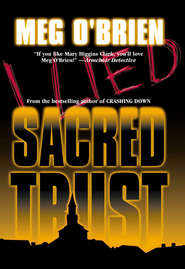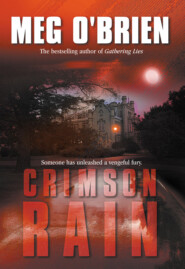По всем вопросам обращайтесь на: info@litportal.ru
(©) 2003-2025.
✖
The Final Kill
Автор
Год написания книги
2018
Настройки чтения
Размер шрифта
Высота строк
Поля
Ben took the same chair he’d had before, next to Lessing, who gave him a nod as if Ben had merely excused himself a few minutes to use the restroom. Kris Kelley’s expression was noncommittal as she took her own seat.
Lessing looked at a man halfway down the table. “Agent Bollam?”
“Sir.” The agent walked over to the light switch, flicking off the overheads. Pulling a cart that held a slide projector from a corner, he positioned it behind and to the right of Agent Lessing. Pointing it toward the far wall so that everyone could see, he said, “I’d like to begin with some background.”
He brought up a photograph of two people who looked to be in their twenties or early thirties. The woman had long, curly, strawberry-blond hair that looked windblown and covered half her face. It didn’t hide her smile, though, nor her beautiful large hazel eyes. The man had black hair, and his arms were around the woman from behind, holding her tightly and smiling, his cheek against hers.
“These are Alicia Gerard’s parents,” Bollam said, “Pat and Bridget Devlin.” Behind them was a sign that read Dublin Automotive Services, and in one of the open bays was a dark blue car that Ben, a classic-car nut, recognized as an Irish-built MG Midget, circa 1960s.
“That photo was taken about forty years ago,” Bollam said. “Pat and Bridget Devlin would be in their sixties now.”
He changed the slide to one that depicted the scene of an accident. There were police cars, ambulances and a crowd gathered along a highway with a steep cliff on one side. At the bottom of a ravine was wreckage.
“Some of you might recall hearing about a school bus being blown off the road in Ireland in the seventies. Twenty-eight out of the twenty-nine children aboard were killed.”
A few of the agents nodded.
“Pat Devlin was—is,” he corrected himself, “a brilliant man, a scientist with ties to the IRA. His specialty, in those days, was building explosive devices. After the school bus attack, fragments of the bomb were found, as were certain ‘fingerprints,’ as they say—details in its construction that led straight to Pat Devlin.”
“My God,” Ben said. “H. P. Gerard’s father-in-law? He blew up that bus?”
“Long before Alicia ever met H. P., of course. She would have been around five at the time. And while Pat Devlin did build the bomb the IRA used, he may not have known precisely what it was about to be used for. Reportedly, he was so sickened by the deaths of those children, he tried to get out of the IRA. As the country’s top expert in explosives, however, Devlin was too useful to them. They threatened his family if he tried to leave.”
“But he did leave,” one of the agents pointed out.
Lessing nodded. “He somehow got false papers for his family and fled Ireland overnight with Bridget and Alicia, leaving their home just as it was—food on the table, mail in the box, cat in the yard.”
“Incredible,” Ben said. “How do you know all this?”
“I can’t reveal our sources,” Lessing answered. “Sorry. But let me get to the point. We have solid information—not just chatter—that a splinter group of the IRA calling themselves The Candlelights are using Pat Devlin again. This time, he’s in America, and he’s building the most devastating explosive device this country has ever seen. The Candlelights plan to use it on the fourteenth of this month—exactly one week from today.”
He paused, and his mouth twisted slightly. “Unfortunately, we’ve had no luck finding The Candlelights, and we don’t know where they plan to attack. Our mission, therefore, is to find Pat Devlin. That bomb must never be completed.”
Good God, Ben thought, be careful what you ask for. All I wanted was a little more action, and now…
Lessing’s cell phone rang, and he left the table for a few minutes to take the call. When he returned, Bollam began again.
“As I was saying, Pat, Bridget and Alicia Devlin left Ireland rather abruptly when Alicia was five, using false papers to enter the United States. That would be thirty-five years ago. We know they lived under different assumed names in Philadelphia for a while, then Miami and Los Angeles. We also know the Irish police spent three years looking for them without success, before moving on to what they called ‘more important’ matters. Meantime, this splinter group of the IRA, The Candlelights, was also looking for the Devlins. Every time anyone thought they’d caught up with them, however, they’d find an empty apartment or house. The Devlins apparently knew, somehow, when they were about to be caught.”
Ben spoke up. “So you think someone was helping them out.”
“We have to assume that was the case,” Bollam said.
One of the agents at the table asked, “Do we know where this group, The Candlelights, came from? What’s their agenda?”
“As I understand it,” Bollam said, “in the early days of the Troubles, as they call it, women in Ireland used to leave a candle burning in a window every night, to welcome the men home after their ‘activities.’ We don’t know why, but the name seems to have been picked up by this new splinter group. As to their agenda, it’s the same as all terrorist groups—to throw people into fear and create chaos.”
He flipped the slides to show two plain, inexpensive-looking cottages and an apartment house. “The Devlins’ cottages were in Philadelphia and Miami. The apartment house is on Crenshaw in L.A. This is all we have on them. Over the years, the Irish police and the IRA apparently gave up hunting for them. There’s been little interest, until recently, in finding Pat Devlin.”
He stopped to take a sip from his glass of water, then pulled out a handkerchief to wipe his chin and tie where the water had dribbled.
“Ah, geez, Joe,” a pink-faced agent with bright red hair said. “You were looking so professional up there till now.”
There was mild laughter from the other agents, and a smile from Bollam. “Just don’t forget I’m your senior,” he said.
“In age, maybe,” the first agent came back with.
“We don’t have much time,” Lessing reminded them.
Everyone quieted down and Bollam continued. “As I was saying, no agency with an interest was ever able to find Pat and Bridget Devlin. There’s no record of them having become naturalized citizens, so if they’re still in this country, they’re here illegally. Unfortunately, it seems they’ve changed their names and identity papers every time they’ve moved, so they’re living as much underground as if they were in a witness protection program.”
“Is that a possibility?” Ben asked.
“Not that we know of—and presumably, we would. To hide out the way they have, there must have been someone helping them. Especially recently, given the new technologies we have for finding terrorists—” he paused and looked around the table “—it must be someone with experience at hiding people, someone who can provide false identities and money.”
Вы ознакомились с фрагментом книги.
Приобретайте полный текст книги у нашего партнера:
Приобретайте полный текст книги у нашего партнера:









